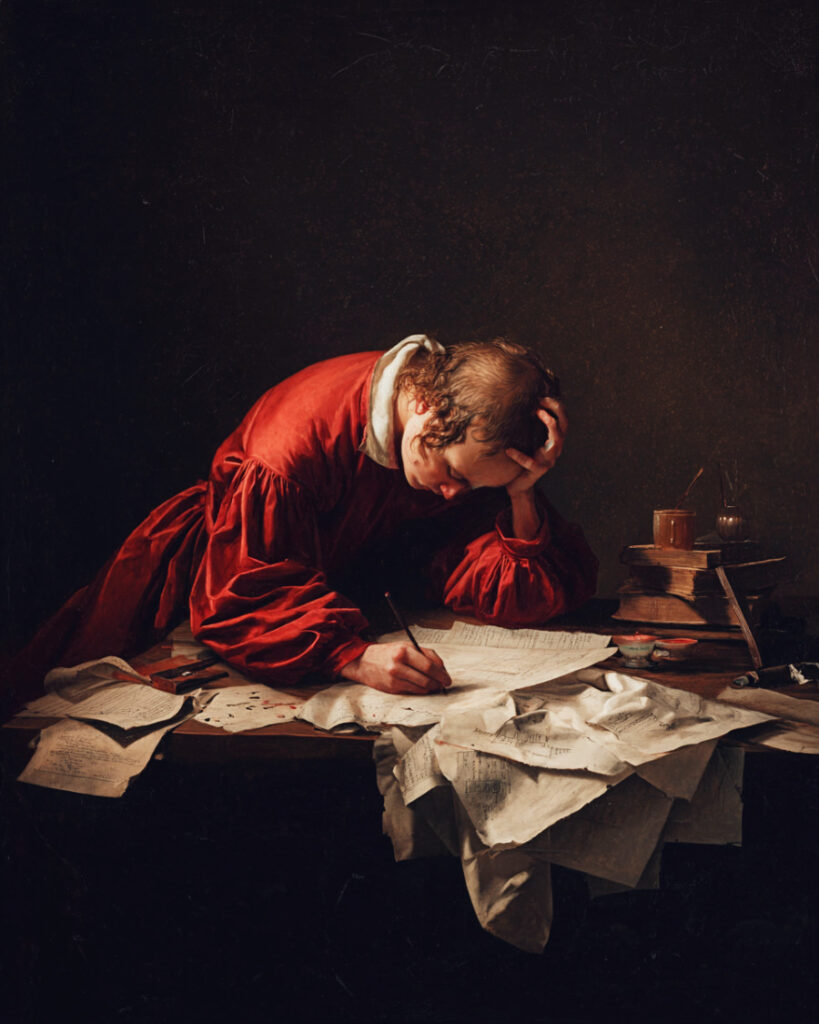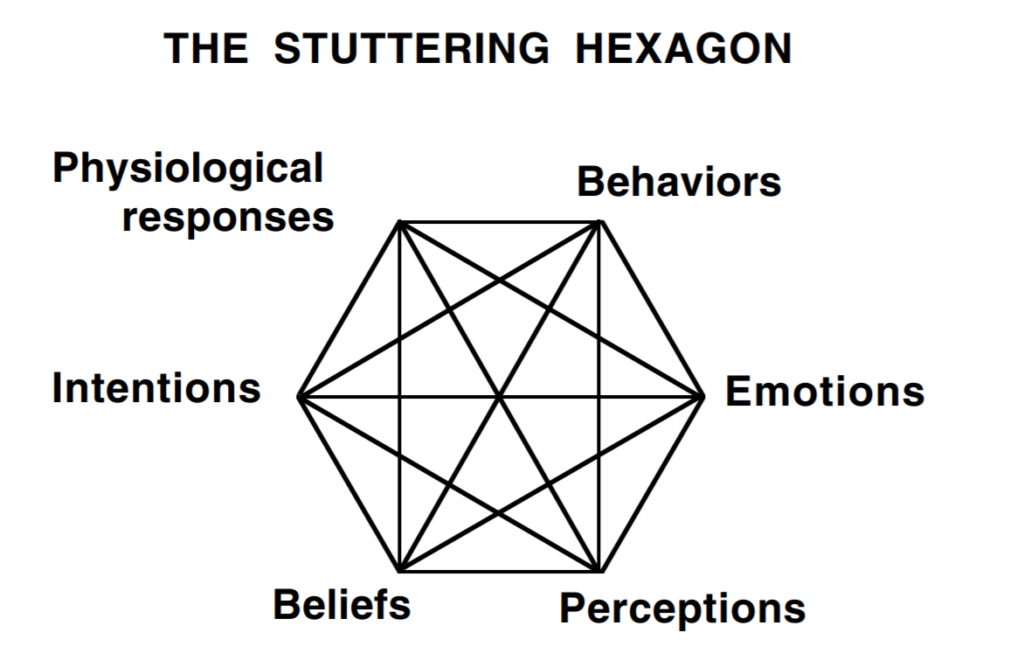Beating the Block: A Simple Guide for Constant Creativity

Artist’s block is real. But it’s also not as bad as you think. In fact, it’s pretty easy to overcome, and there are a lot of ways to do it.
Before we can beat the block, though, we have to backtrack and understand what causes it.
What Causes Artist’s Block?
There’s a book by John C. Harrison called ‘Redefining Stuttering’ that discusses why people stutter. In it, Harrison uses a hexagon of attributes (pictured below) that influences why, when, and how much people with speech impediments stutter (or “block”) in any given situation.
It begins with physiological responses – which we’ll ignore for the moment – and moves on to cover:
- Behaviors
- Emotions
- Beliefs
- Perceptions
- Intentions

So how do these attributes apply to artist’s block? Let’s break it down:
Behaviors
When the art block sets in, what do you do? Stop creating? Watch TV or play video games? Hang out with friends to feel better about yourself? Sit around moping?
These kinds of behaviors are normal responses to artist’s block, but ultimately do nothing to alleviate it.
Emotions
How you behave during a block is a direct result of your emotional state. Some common themes include:
- Fear of failure
- Annoyance at others’ talent
- Frustration at your lack of skill
These (and many more) can all cause bad behaviors to develop AND persist until the negative emotions are dealt with.
Perceptions
Perceptions are what we believe in the moment, and are shaped by our beliefs, expectations, and state of mind.
For example: You create an Old Master copy and end up hating it because you only see the mistakes. Whereas an onlooker might see a masterly crafted copy and not even notice the imperfections.
Beliefs
What you believe about yourself and your art has a direct impact on your perception of your work, your emotional state while you work, and your behavior towards your work.
Intentions
One of the more subtle ways we can self-sabotage during an art block is through our intentions, or what we expect to happen.
A great example of intent was described in this video. Basically, your friend tells you to go into a room and study every yellow object in it for one minute, then leave the room. Your friend then asks you to tell him/her all of the brown objects in the room. You, of course, can’t recall them because you went into the space with the intention to ONLY study the yellow objects.
Going into a piece with the right intentions is one of the most important pieces of the hexagon. A self-defeating attitude will only lay the foundations for failure and lead you right back to bad behaviors.
What To Do If You Have Artist’s Block
Relax.
Step back from your work, take a breath, and realize that every great mind in history has been where you are right now.
Then, review the causes of the block and begin shifting your attitude for each of the 5 hexagon points.
Better Behaviors
One of the best ways to beat any kind of block is by staying creative in a way that doesn’t require you to generate ideas. There are a plethora of options available:
- Studies of Old Masters
- Analyzing the composition of your favorite scene in a movie/tv show
- Copying the work of a contemporary you admire
- Doodling/sketching things you don’t normally draw
Also consider Reddit, host of r/SketchDaily, arguably the best place for a daily drawing prompt. r/RedditGetsDrawn and r/ICanDrawThat are also great options!
Better Emotions
It’s hard to feel good about failure. In most cases, you probably won’t.
Emotional resilience is a lifelong skill, especially for creatives. It requires you to detach yourself completely from the work and become an observer. Start by identifying the emotions you feel when a block hits, and then work out your why and what.
- Why are you frustrated, angry, envious, sad, mad, or upset?
- What can you do about it?
Once established, you’re already in a much better place to address the underlying problems with a clear, rational mind.
Better Perceptions
If social media has taught us anything, it’s that truth and beauty aren’t bedfellows. In fact, most of what you see online is doctored in some way, shape, or form.
It also doesn’t help that metrics such as comments, shares, likes, and followers alter our perception of good versus bad work.
To remedy this, it pays to remember that everyone is on their own journey. That artist you admire who creates breathtaking pieces every week has probably spent 20 years working every day to be that good.
The most important takeaway here is that you should always stay true to _your_self, _your _skills, and _your _talents. Don’t measure your accomplishments by the deeds of others.
Better Beliefs
Beliefs are formed in two ways:
- What we’re taught to believe
- What we believe to be true through our own experiences
Start by examining what you’ve been taught. As children we take what our parents and figures of authority say as gospel truth. But they – like us – have their own beliefs about the world around them. And they aren’t always right.
Secondly, reshape negative experiences into positive ones. How? By finding the silver lining. Cheesy, yes, but highly effective.
Instead of looking at a work as a failure, look at it one way NOT to represent that particular subject. Simple shifts like this can help alter beliefs and – by extension – perceptions.
Better Intentions
Map our your journey. Whether it’s a few hours of work or a few minutes, write down what you want to do and focus on checking things off.
If your goal is to learn to draw hands, don’t set yourself up for failure by saying: “I’m going to draw 100 amazing hands right out of the gate”. Break it down into bite-size steps:
- Study the anatomy/proportions of the hand by looking at references images, 3d models, and any other resources you need
- Break the hand down into simple shapes you can draw from any angle
- Rectangular blocks for the fingers
- A distorted square for the palm
- Choose some simple hand poses to sketch using only the basic shapes and anatomical/proportional knowledge you’ve gained
Once you feel comfortable, move up in difficulty to some light shading and more difficult poses.
What NOT To Do If You Have Artist’s Block
Now that you know what can cause a block and how to deal with it, it’s time to put bad habits to rest.
Don’t Wait For “Divine Inspiration”
Similar to how an overweight person needs to bypass the snack aisle at the supermarket to lose weight and see visible results, an artist needs to keep his/her hands busy to create their next masterpiece.
Picasso put it best when he said: “Inspiration exists, but it has to find you working.”
Don’t Stop Creating New Work
If you’ve ever left paint on a palette for extended periods of time, you know it is an absolute pain to get off.
Not being creative for weeks, months, or years has the same effect. Your skills solidify and you plateau. It becomes infinitely more difficult to chip away the mental “dust” that’s built up during your absence from the canvas.
Don’t Stop Learning New Things
One of my favorite drawing books, “How To Draw”, gave a great example of why drawing is hard for a lot of people: They haven’t studied something enough to know how to represent it in 2d space.
It’s not an all encompassing reason, but it puts a lot of things into perspective. Does your piece look flat? Could be a perspective problem. Are your characters lifeless? Could be a posing issue, or perhaps your lighting isn’t right.
Being able to ask yourself the right questions becomes mechanical. They come more easily simply by studying and observing the world around you.
Final Words
Blocking sucks, but it’s not the end of your creativity. What you do and think in those moments when the watering hole dries up are crucial to gradually shortening those periods of creative drought.
© 2025 Visaic. All Rights Reserved.
